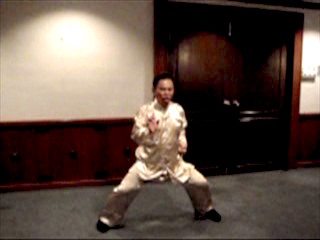TENSE YOUR ARM, DON'T TENSE YOUR ARM

One-Finger Shooting Zen
Question
In the book, "The Art of Shaolin Kung Fu", Sigung explains that in performing One-Finger Shooting Zen, "as you move your hand out and in, tense it and visualize it as charged with internal force" and then "even though you tense your arm and finger, you must never be tensed, especially in your chest"
So how to tense without tensing? If tensing the muscles is one of the biggest mistakes, how to do One-finger Shooting Zen correctly?
http://www.wongkiewkit.com/forum/showthread.php?12258-Questions-on-One-Finger-Shooting-Zen.
— Karol, Norway
Answer
It is a good question.
Let us have some fun. In performing One-finger Shooting Zen, you should tense your arm, and not tense your arm. The confusion is due to the limitation of words. Words do not explain exactly what we want to explain.
The first "tense" in "you should tense your arm" is not the same as the second "tense" in "not tense your arm". Although the meanings are different, I still used the same word "tense" when I wrote the book 20 years ago in 1995 because I could not find another better word.
After many years of teaching, now I use words that give a clearer meaning. Now I say, "Focus your energy at your index finger, but do not use muscular strength", or "Consolidate your flowing energy at your arm without tensing any muscles".
In other words, in "tense your arm", I mean "focus or consolidate energy at your arm". In "not tense your arm" I mean "not tense the muscles in your arm".
When you focus or consolidate energy at your finger or arm, your energy is still flowing, but it is focused or consolidated. The consolidated energy is flowing, not locked up or stagnant. You do not tense your muscles when you let your energy flow. If you tense your muscles, the energy will be locked up and be stagnant.
Such limitation of words occurs quite frequently in chi kung and kungfu descriptions. For example, after a few repetitions of a Sinew Metamorphosis exercise, we tell students to breath out forcefully but without using force! In developing internal force, we advise students not to use strength and they will develop a lot of strength.
In the "breathing" example, breathing out forcefully means breathing out with a lot of energy going out of the mouth. Without using force means without breathing out in a forced manner.
In the "internal force" example, the first "strength" means "muscular strength", and the second "strength" means "internal force". If we use muscular strength, we have to tense our muscles. When we tense our muscles, we stop the flow of energy that constitutes internal force.
The uninitiated will not understand the meaning of the descriptions although they know the dictionary meaning of all the words used. The initiated will have no difficulty understanding the meaning because they have experience of the situations.
The above is taken from Question 8 of November 2015 Part 2 of the Selection of Questions and Answers.
LINKS
Courses and Classes
